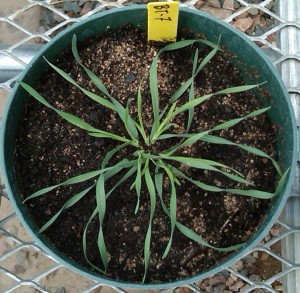
I’ve been meaning to write a post on monoculture for quite some time. In fact, I began writing this post over 8 months ago, but for various reasons this topic never made the top of my priority list. This tweet by Michael Pollan finally prompted me to revisit this topic:
Grist take on the Harmon OJ piece, reminding us that the real problem to which GM is “the solution”is monoculture. http://t.co/lQDg48SdgI
— Michael Pollan (@michaelpollan) July 29, 2013
Pollan was referring to a Grist article by Nathanael Johnson, which was a response to Amy Harmon’s excellent piece in the New York Times. Both of their articles are worth reading (as is some of the controversy around one of Michael Pollan’s other recent tweets on the issue), but I’d like to stick with Pollan’s criticism of monoculture. Michael Pollan has been blaming monoculture for the problems of modern agriculture for quite some time.
“I still feel that the great evil of American agriculture is monoculture.” – Michael Pollan
Pollan may be the most recognizable, but he is certainly not the only one to blame monoculture for many of the problems of modern agriculture. This is a pretty common refrain from the anti-GMO camp, and also from many folks who are just not big fans of conventional agriculture. There are even some who claim to be allergic to monocultures. So is monoculture evil as Pollan says? Well, it may depend on what you mean by monoculture.
What’s a monoculture?
The biggest problem with monoculture might be your interpretation of the term. How, you might ask, could there be multiple interpretations of the word monoculture? I mean, there are very few words in the agricultural vocabulary that are as intuitive as the word monoculture.
Mono: single + culture: the tilling of the land.
Put them together, and it is pretty clear that a monoculture is the tilling of the land for a single crop. And most dictionary definitions reflect this intuitive meaning.
Monoculture:
- The cultivation of a single crop in a given area – WordNet
- The use of land for growing only one type of crop – Dictionary.com
- The cultivation or growth of a single crop or organism especially on agricultural or forest land – Merriam Webster

So if you grow a single crop, you are growing a monoculture. Simple as that. The problem with this term is the scale. How much “given area” or “land” is required before we call it a monoculture? How long must a single crop be grown on the same area of land before it is considered a monoculture? The word is very imprecise. It seems to be used far more often by people criticizing modern agriculture than those who actually practice agriculture; I presume it is due to the non-specificity of the term. It doesn’t really convey enough information to be very useful to practitioners. It is the scale of the monoculture (both temporal and spatial) that determines whether monoculture is useful or problematic (or both) from an agronomic point of view.
What are the problems associated with monoculture production?
It has been my experience that most who criticize monoculture production don’t usually provide many details about why monoculture is a problem. And more importantly, they rarely provide specific, practical suggestions for improvement. So I think it is important to discuss these issues and place them in context. First, though, it is important to recognize that there are many good reasons to grow crops in monoculture. Monoculture is a practice that has allowed many technological advances in crop production. Having only one crop in the field increases our ability to mechanize planting, weeding, and harvest. And the mechanization of agriculture is the reason a majority of the population in developed countries do not still work on a farm. Without mechanization, growing your own food is often a necessity, not a hobby.
Some notable historical examples of widespread monoculture:
- The Irish potato famine. Potatoes reproduce vegetatively (not by seed) and therefore most potatoes grown in Ireland in the 1830s and 1840s had identical genetics. ‘Irish Lumper’ potato was grown extensively, and also happened to be extremely susceptible to late blight (caused by Phytopthora infestans). Potatoes had become the primary food source for the poor, and when the disease was finally introduced to the region, massive crop failure was inevitable. Nearly the entire potato crop in all of Ireland was susceptible to the pathogen. In the 1840s, late blight devastated the potato crops throughout the country; many people starved, and the population of Ireland crashed.
- Victoria oat blight. The oat variety ‘Victoria’ was bred to be resistant to crown rust, a problematic disease in oats. By 1945, well over half of US oat production had Victoria oat as a parent line. Then a new fungal pathogen came along, and it turns out that Victoria oats were highly sensitive (the pathogen was later named Victoria blight). It turned out the same gene that resulted in resistance to crown rust (interestingly, due to a hypersensitive response), also resulted in high susceptibility to Victoria blight. Because so many of the oat varieties had this particular gene, losses were widespread.
- Texas Male Sterility. In order to make corn hybrids, breeders must have a male parent and a female parent growing in close proximity. It is also necessary to have the male plants provide the only source of pollen. To ensure the females don’t self pollinate, the female plants are de-tasseled, so only the desired male parent plants produced pollen. Corn de-tasseling is expensive and labor intensive (and a generally not-fun job). Then the Texas cytoplasm (cms-T) was discovered (cms for cytoplasmic male sterile, and T for Texas). Use of cms-T meant there was no need to de-tassel the corn. Because the cms-T made it so much easier to produce hybrids, up to 90% of the US corn crop contained cms-T in the late 1960s and early 1970s. But along with male sterility, the cms-T also resulted in dramatic susceptibility to Bipolaris maydis or Southern Corn Leaf Blight (SCLB). Which meant 90% of the US corn crop was extremely susceptible to SCLB. Corn yield losses over a 2 year period were dramatic, and use of cms-T was rapidly discontinued.
Certainly, these examples illustrate a fundamental problem with large monoculture over a large geographical region (the spatial scale). But even more than that, they illustrate what can happen when we rely on extremely narrow genetics within a crop that is grown on a large scale. They all tell the same basic story: over-reliance on a single genotype is a bad idea, because it makes the entire crop susceptible to a single pest outbreak. If there were multiple varieties of potatoes being grown (instead of only Irish Lumper), and some of them were less susceptible to late blight, perhaps the Irish potato famine would have been avoided. If there were multiple sources of male sterility in use in corn, widespread losses due to SCLB may never have happened. One of the first things most agronomy students learn is that using diverse genetics minimize problems like these.
Widespread planting of uniform genetics is at least part of what Pollan (and others) don’t like about monoculture. He says as much in a 1998 article, when he mentions monoculture being “exquisitely vulnerable” to pests.
Organic farmers like Heath have also rejected what is perhaps the cornerstone of industrial agriculture: the economies of scale that only a monoculture can achieve. Monoculture — growing vast fields of the same crop year after year — is probably the single most powerful simplification of modern agriculture. But monoculture is poorly fitted to the way nature seems to work. Very simply, a field of identical plants will be exquisitely vulnerable to insects, weeds and disease. Monoculture is at the root of virtually every problem that bedevils the modern farmer, and that virtually every input has been designed to solve. – Michael Pollan, Playing God in the Garden
In addition to pest vulnerability, Pollan makes a couple other interesting references in this passage. Pollan’s comment that “monoculture is poorly fitted to the way nature seems to work” implies that there are no natural ecosystems in which a single plant species dominates. This is simply not the case. I’ve seen relatively undisturbed habitats in the Big Horn Basin of Wyoming that contain almost no plants other than greasewood (Sarcobatus vermiculatus). And saline sites where nothing but foxtail barley (Hordeum jubatum) grows. And riparian areas where only common reed is present. Again, this is an issue of scale; if you zoom in to an acre, there is a naturally-occurring monoculture. If you zoom out far enough, you’ll see other plants in the community. But this is exactly what we see in crop production in most regions also; within a particular field there may only be a single crop, but if you zoom out, you see different crops, nearby riparian areas, pastures, etc.
Notably, Pollan’s definition of monoculture also goes beyond the spatial scale and incorporates the temporal scale (“year after year”). Steve Savage has previously recognized that those critical of “monoculture” are often referring primarily to this temporal aspect; growing the same crop year after year in the same field. Crop rotations would not be considered “monoculture” by many of these critics, even though only a single crop is grown at a time within a field. Although organic farmers get a great deal of well-deserved credit for the diverse rotations they commonly use, crop rotation is still a major (although apparently under-recognized) part of conventional agriculture as well. For example, over 80% of soybean growers in the U.S. use crop rotation for pest management. Perhaps these rotations are not as diverse as they should be. Lack of crop diversity (both spatially and temporally) is certainly a valid concern. Savage suggested that with respect to the temporal aspect, critics of modern agriculture should avoid using the term monoculture altogether, and instead discuss “diverse rotations” and “non-diverse rotations”. This would eliminate the ambiguity, and instead allow an actual discussion of some of the real problems caused by a lack of diversity in crop rotations.
So how do we fix the problems of monoculture?
Researchers at Iowa State University have proposed one possibility: strip intercropping. It is a really neat idea that provides some balance between the benefits of monoculture, and the benefits of polyculture. But it presents some unique problems as well. Some pest outbreaks may actually be worsened in this system. A primary reason for crop rotation over time is to break pest life cycles; a sugarbeet pest that cannot survive on corn or dry bean, for example, will be reduced in a three-year rotation of these crops. However, if we employ strip intercropping, there will be sugarbeet in the field each year of production, providing the opportunity for the pest to build up and be worse than in a conventional crop rotation. I suppose one could argue that Pollan is correct when he says “Monoculture is at the root of virtually every problem that bedevils the modern farmer,” but only because that is how modern farmers grow crops. If modern farmers universally adopted polyculture, a new set of (equally bad) problems would result. And then polyculture would be at the root of virtually every problem farmers faced.
For some perennial crops (like tree crops and vineyards), a diverse crop rotation over time is simply impossible. It takes years for these crops to become productive, and they are extremely costly to establish. Perhaps we could inter-plant other species between tree rows or vines to reduce monoculture. But it is unlikely that this would actually aid in the management of many pests, as the susceptible hosts would still be present in a relatively high density. Adding diversity to the genotypes grown is only helpful if there are resistance traits found within the species. Some pests, like the citrus greening pathogen/vector (the pest that Amy Harmon wrote about in the NY Times), have a broad host range that includes most citrus crops, and there is currently no known natural source of resistance within these species. So reduction in this monoculture would be unlikely to help the situation much. Which, in my opinion, makes Michael Pollan’s claim that the “real problem to which GM is “the solution” is monoculture” is simply false in many contexts.
Are monocultures problematic? Sure, if the geographic or temporal scale is large enough. But the problems solved by using monoculture on a field-scale tend to far outweigh the problems they cause. Is there room for improvement? Absolutely. And there are many researchers who are attempting to do just that. For example, I am beginning a new 5 year project to look at how diverse crop rotations and tillage may impact the development of herbicide resistant weeds. But long-term field research like this is expensive. And public investment in agricultural research has stagnated or declined in the last decade. The problems associated with monoculture production won’t be solved simply by complaining about monoculture. And “simple” solutions like diverse crop rotations, polyculture, or use of biotech crops may solve some issues associated with monoculture, but they will exacerbate others issues. As is often the case in agriculture, the problems attributed to monoculture are far more nuanced and complex than most critics realize.
So I’m in favor of a genuine discussion about the problems commonly attributed to monoculture production. And I hope to help develop practical, economical ways to combat those problems. It just isn’t as simple as calling monoculture evil. To paraphrase Churchill, my opinion is that monoculture is indeed the worst possible way to grow crops, except for all the others that have been tried from time to time.


Comments are closed.